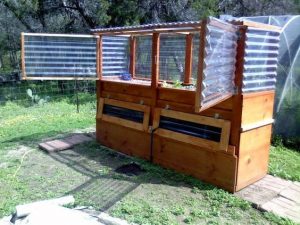What it is:
-
- A standardised and Open Source Aquaponics system
-
- Suitable for temperate climates.
- Affordable but capable of producing useful food
Why?
Our food system works chiefly on inputs of fossil fuels, industrially produced fertilisers and pesticides. This puts well documented and increasing pressures on biodiversity, climate stability and soil health.
Instead of chemical inputs, the waste from the fish fertilises the plant crops, which in turn filter the water for recirculation.
What is it?
A standardized 600 litre Aquaponics kit for growing fish and plants together outdoors in a symbiotic system. It will be a mobile modular unit that can be placed in an urban area and will grow food without needing soil. The Aquaponic Research Kit will be designed for outdoor use in a temperate climate, featuring good insulation and hardy fish.
The ARK uses automated light sensors to make sure the system recieves the optimum light and warmth to produce healthy crops and fish. When light and warmth is high, the hatch opens automatically to cool the system. When not enough light is detected, the top hatch closes for insulation and daylight LEDs are activated until the optimum lighting time is reached.
The season extension afforded by the large thermal mass of water and super insulation means that even for those with outdoor space an ARK system can help them get plants started earlier, or provide a space for overwintering exotic plants.
We’ll build in everything we’ve learnt over the last five years of our own aquaponic experimentation. It will be designed so that it is small enough to be moved by two people, and transported in a van.
We’ll sell the units to schools, colleges and Universities as well as community gardeners, allotment holders and producers. It will build the capacity of growers to manage Aquaponic systems, and increase the skills available for larger scale units.
The system will enable both academic and citizen-led research to take place on a common, well-documented platform. Having a ‘standard’ reference system will make it possible to compare variables between systems more easily. They are small and cheap enough to install three for properly rigorous triplicate academic work.
As part of the kit we’ll provide sensors & tools so that the units can be connected to the internet. The sensors will share system data to online graphing and record keeping systems. We’ll build a community of practice in an online forum and build on our existing network of aquaponicists to provide peer support.
The water based ARK system does not rely on soil and can be placed on concrete or tarmac anywhere.
The season extension afforded by the large thermal mass of water and super insulation means that even for those with outdoor space an ARK system can help them get plants started earlier, or provide a space for overwintering exotic plants. The fact that the ARK system is designed for outdoor use makes it ideal for labs or classrooms that have very limited indoor space.
Basic Kit
£400 parts target (Ballpark £600 shipped cost)
-
- Well insulated single IBC system with media grow bed above tank
-
- Dual Airlift pump
-
- < £30 ESP Temp & EC sensor
-
- Transparent Polycarbonate inner cover
-
- Automated inner cover opener (Fish welfare)
- Insulated cold weather cover (10+ cm foam) – Manual operation
Add ons
-
- < £50 Computer controlled outer cover closer
-
- < £50 Temp compensating Automated Open Source fish feeder
-
- < £100 12v supplemental T5 lighting system with computer control
- < £200 12v supplemental LED Lighting system with computer control ( 7 x IKEA Vaxxer)
Citizen Science
- By standardising certain parameters we can more easily tweak our systems and know what’s working
- Creation of a ‘reference system’ will enable citizen scientists to compare their trials to others.
Roadmap
– Prototype our latest Alpha functional designs
– Finalise the light sensor operation
– Complete work on the exterior aesthetic design
– Verify the design by operating it for two months
– Finalise the sensor stack
– Iterate the design, Produce an Alpha version 0.2
– Give two test systems away, one to a school and one to a experienced aquaponicist to use
– Iterate the design, Alpha version 0.3
– Document the design
– Release a Beta kit 0.4
Imagined Timeline
- We build 5 -10 systems this year, find we can’t keep up with demand.
- We outsource some of the fabrication to friendly local fabricators. They identify design simplifications and improvements. We iterate the Open Source design.
- We throw up some documentation on our forum, people improve it, versions happen.
- Schools buy the system, kids learn about food, about nutrient cycles. The older ones do some microprocessor coding to tweak and improve the sensor systems.
- A bunch of universities build them, the postgrads have neat ideas,there’s
forks, the community builds momentum, we get a bit of press in glossy magazines.
- The community establishes a food waste feed pathway, via black soldier flies we can now feed our fish sustainably.
- We’re producing significant protein-rich food in urban environments using circular economy principles. What was once waste is now a valuable resource.
- The systems pop up in deprived &Low income
areas, people increasingly feel agency and empowered to grow fresh greens and fish.
